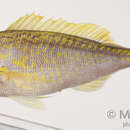Diagnostic Description
provided by Fishbase
Interorbital space flat. Dorsal and anal fins without scales, their last soft rays extended in short filaments. Pectoral fins long, reaching level of anus. Scale rows on back parallel to lateral line. Body purplish or brownish violet; sides with numerous yellow spots or faint yellow, chevron-shaped bands; the upper lobe of the caudal fin yellow; dorsal fin yellowish to yellowish-brownish.
Morphology
provided by Fishbase
Dorsal spines (total): 10; Dorsal soft rays (total): 11; Analspines: 3; Analsoft rays: 8
Trophic Strategy
provided by Fishbase
Occurs over rocky bottoms; off Guam, caught most abundantly from 180 to 270 m . Feeds on fishes and salps. Attains length 40 cm (Ref. 58472).
Biology
provided by Fishbase
Adults are found over rocky bottoms; off Guam, caught most abundantly from 180 to 270 m (Ref. 55). They feed on fishes and salps. Marketed fresh (Ref. 55).
Importance
provided by Fishbase
fisheries: commercial; gamefish: yes
分布
provided by The Fish Database of Taiwan
分布於印度-太平洋區,西起模里西斯,東至夏威夷群島,北至日本南部,南迄澳洲及新加勒多尼亞。台灣主要分布於南部及東部海域。
利用
provided by The Fish Database of Taiwan
味美之食用魚。一般以深海一支釣及底層延繩釣捕獲。煎食或煮湯皆宜。
描述
provided by The Fish Database of Taiwan
體呈長紡錘形;標準體長約為體高之3.0-3.2倍。兩眼間隔平扁。眼前方無溝槽。下頜突出於上頜;上頜骨末端延伸至眼前緣的下方;上頜骨無鱗。上下頜骨具帶狀齒,外列齒擴大,前方數齒呈犬齒狀;鋤骨具三角形齒帶且其後方無突出部;腭骨亦具齒帶。鰓耙數28-29。體被中小型櫛鱗,背鰭及臀鰭上均裸露無鱗;側線完全且平直,側線鱗數70-74。背鰭硬軟鰭條間無深刻;背鰭與臀鰭最末之軟條皆略為延長而較前方鰭條長;背鰭硬棘X,軟條10-11;臀鰭硬棘III,軟條8;胸鰭長約等於頭長;尾鰭深叉。體藍紫色,體側有黃斑散佈。背鰭及胸鰭黃綠色;尾鰭上葉鮮黃色,下葉黃綠至藍紫色;腹鰭及臀鰭色淡。依據
Nelson(1994)將其置於笛鯛(Lutjanidae)科中的濱鯛亞科(Etelinae)。
棲地
provided by The Fish Database of Taiwan
主要棲息於近海水深約90-360公尺岩石底之海域。獨自游動或聚集小群。主要以小魚及被囊類動物為食。
Pristipomoides auricilla
provided by wikipedia EN
Pristipomoides auricilla, the goldflag jobfish or the yellow flower snapper, is a species of ray-finned fish, a snapper belonging to the family Lutjanidae. It is found in the Indo-Pacific region.
Taxonomy
Pristipomoides auricilla Was first formally described in 1927 by David Starr Jordan, Barton Warren Evermann and Shigeho Tanaka with the type locality given as Honolulu.[3] The specific name auricilla means “gold tail”, a reference to the yellow upper caudal fin lobe.[4]
Description
Pristipomoides auricilla has an elongated but robust body. The space between the eyes is flattened, the jaws are roughly equal in length, although sometimes the lower protrudes slightly. There is an outer row of conical and canine teeth and an inner band of bristle-like teeth on each jaw. There is a triangular patch of vomerine teeth but there are no teeth on tongue. The caudal fin is forked.[5] The dorsal fin contains 10 spines and 11 soft rays while the anal fin has 3 spines and 8 soft rays, the final ray on each of these fins is extended into a filament. The long pectoral fins extend as far as the anus. The overall colour of the body is purple to brownish purple marked with many yellow spots and in distinct yellow chevrons. The upper lobe of the caudal fin is yellow and the dorsal fin is yellowish. This fish attains a maximum total length of 45 cm (18 in), although 25 cm (9.8 in) is more typical.[2]
Distribution
Pristipomoides auricilla Has a wide Indo-Pacific distribution which extends from the Comoros Islands in the east to Hawaii, south to Australia and New Caledonia and north to Japan.[1]
Habitat and biology
Pristipomoides auricilla is found at depths between 80 and 360 m (260 and 1,180 ft), where they are found over rock reefs and rock substrates. They are predatory, feeding on other fishes, tunicates and salps.[1]
Fisheries
Pristipomoides auricilla is fished for using deep handlines. In some area, such as the Marianas, it is subjected to heavy fishing pressure.[1] This species is sold fresh.[2]
References
-
^ a b c d Russell, B.; Lawrence, A.; Myers, R.; Carpenter, K.E.; Smith-Vaniz, W.F. (2016). "Pristipomoides auricilla". IUCN Red List of Threatened Species. 2016: e.T194351A2319116. doi:10.2305/IUCN.UK.2016-3.RLTS.T194351A2319116.en. Retrieved 19 November 2021.
-
^ a b c Froese, Rainer; Pauly, Daniel (eds.) (2021). "Pristopomoides auricilla" in FishBase. February 2021 version.
-
^ Eschmeyer, William N.; Fricke, Ron & van der Laan, Richard (eds.). "Species in the genus Pristipomoides". Catalog of Fishes. California Academy of Sciences. Retrieved 18 May 2021.
-
^ Christopher Scharpf & Kenneth J. Lazara, eds. (5 January 2021). "Order LUTJANIFORMES: Families HAEMULIDAE and LUTJANIDAE". The ETYFish Project Fish Name Etymology Database. Christopher Scharpf and Kenneth J. Lazara. Retrieved 16 May 2021.
-
^ Gerald R. Allen (1985). FAO species catalogue Vol.6. Snappers of the world An annotated and illustrated catalogue of lutjanid species known to date (PDF). FAO Rome. pp. 146–147. ISBN 92-5-102321-2.

- license
- cc-by-sa-3.0
- copyright
- Wikipedia authors and editors
Pristipomoides auricilla: Brief Summary
provided by wikipedia EN
Pristipomoides auricilla, the goldflag jobfish or the yellow flower snapper, is a species of ray-finned fish, a snapper belonging to the family Lutjanidae. It is found in the Indo-Pacific region.
- license
- cc-by-sa-3.0
- copyright
- Wikipedia authors and editors
Habitat
provided by World Register of Marine Species
Known from seamounts and knolls
Stocks, K. 2009. Seamounts Online: an online information system for seamount biology. Version 2009-1. World Wide Web electronic publication.
- license
- cc-by-4.0
- copyright
- WoRMS Editorial Board

